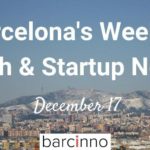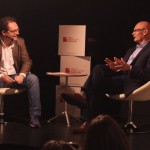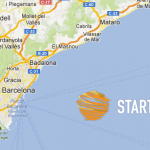This is the third part of a series of posts where Elliott will share his inside track on his experience of going through an incubator program. Check out the other editions here:
- Part I (Great Expectations)
- Part II (Back To School)
- Part IV (Legal & Fundraising)
- Part V (Marketing & Networking)
- Part VI (Pitching, Decks & Financials)
- Part VII (Demo Day & Last Days)
- Part VIII (The Round Up)
Hi there, my name is Elliott. Recently, the well-renowned F10 FinTech incubator accepted my startup Abroaden into their 2021 Barcelona batch.
Clemens from Barcinno kindly invited me to blog about our experience in the incubator as we go through the program.
If you haven’t read part I (Great Expectations) and part II (back to school) yet, I recommend checking them out.
Here’s what happened in a (very) busy April.
Getting ready for round two
F10’s incubation program runs on a cycle of masterclasses and sprints.
During the masterclass, we dive into different verticals of the business.
With the help of different experts brought in to teach us, we deconstruct many of our ideas and processes.
Then, we rebuild our ideas into leaner, more actionable structures with the elements stripped from the excess.
After each masterclass, we get a few weeks to sprint through different milestones.
If we complete the milestones, then we unlock a tranche of funding provided by the incubator.
Thinking about Design Thinking
Every founder starts with a grand vision of their product.
We like to dream — and to dream big.
While that’s great for mapping out a vision, dreams often don’t translate precisely into reality.
For that reason, F10 spent a considerable amount of the week coaching us on design thinking.
If you’re not familiar with the concept, design thinking revolves around building products based on drawing storyboards, quickly developing prototypes then testing your idea with users.
The idea is to get feedback from the people most likely to use your product.
These insights subsequently define your trajectory as you adjust processes, layouts, and even language to meet their needs.
After all, the point of creating a startup is to help people. If you don’t know what they want, then you can’t achieve this goal.
To that end, the whole process keeps you honest and focused on what’s most important – your users.
We had some fantastic feedback from people in our early access group (you can sign up here to join our early access list!).
We’re adopting this technique in how we build out our products.
Always listening
As I mentioned above, we needed to validate our concept and our prototype with our potential users.
After all, these are the people who we want using our product. Why wouldn’t we give them what they want?
The best thing that we can do at our stage (and at any level, really) is to listen to our users.
It sounds a bit cliche, but having put this technique into practice over the past month showed me just how valuable this tool is.
- Tested parts of our product
- Kept asking if we were solving the most pressing problem
- Trialed some language that we use
As a founder with a vision, asking these questions is intimidating as it forces your dreams to confront reality.
Outside of the milestone, we also did a separate test to validate our product.
In short, we followed a technique made popular by Stripe that asks users one question: rank a set of problems from most important to least.
The results were stunning but confirmed our trajectory.
If you’re tinkering with a startup idea, I highly recommend running this test with people.
Getting to the build
Using these insights and design thinking, we remapped our builds and processes.
Juan, our CTO, and one of the co-founders, and I locked ourselves in the incubator space one morning to get to work. (Literally. We learned a lot about building security that day).
F10 turned us onto Miro, which we used on a giant interactive screen to map our ideas.
By the time we emerged from the session seven hours later, we had a leaner, more concrete product roadmap, along with our agile sprints ready to go for the next few months.
We celebrated with burgers and some beer at Black Lab Brewery in the afternoon, which acts as the after-work hangout at Barcelona Tech City conveniently located in same the building complex.
Knowing your co-founder
Co-founding is one of the most vital and most sensitive parts of any startup.
Investors invest as much in people as they do ideas, and with good reason:
Not having the right team members is the number three reason why startups fail.
It makes sense.
If the team at the top isn’t on the same page, how can they execute their vision?
F10 is well aware of this pitfall.
We spent an entire day in a reflective workshop exploring some of the most challenging decisions a team of founders could make.
We compared our vision of the startup’s future, our desired goals, and how to deal with a breakup (amicable or otherwise).
It was a painful exercise, but a necessary one, especially at our stage.
One startup even realized that its founders weren’t in total alignment.
This revelation allowed them to make some personnel changes now and well before becoming a liability down the road.
In the end, every idea-stage startup should have these talks with their fellow co-founders.
(If you’re interested in learning more, here are some free resources from our course instructor, Jana Nevrlka.)

First intro to investors
We ended the last full day of the Masterclass week with one-on-one sessions with investors.
The purpose of these meetings wasn’t so much about getting investment but getting experience talking to the people who could fund you.
To that end, we spoke to investors at all different levels, including angels, venture capitalists, and even a local bank.
Having this practice opportunity is probably one of the most beneficial aspects of being in an incubator.
Ask any entrepreneur, and she’ll tell you how hard it is to get the ability to pitch to an investor — let alone bounce your ideas off of one.
We were able to gain valuable insights, particularly from the VC and the bank, as we wouldn’t normally speak to them at our stage.
In case you are wondering, early-stage startups should generally avoid venture capitalists and institutional investors. These groups either prefer to invest in more mature companies or take a considerable amount of equity to offset their risk.
Lastly, speaking to investors and even presenting is stressful. Doing so in a ‘practice’ environment will only help us pitch better when it counts.
Afterward, we had a small networking session, wrapping up what was an exhausting few days.

Having our work cut out for us.
Like the first masterclass session, we were exhausted by the end of the week.
Unfortunately, there was little-to-no time to breathe.
By the following Monday, we were back at it, hacking through on milestones.
Over the subsequent three weeks, we put what we learned into practice.
By far, speaking to our potential users was one of the most rewarding experiences we had over this time frame.
Greater still is that we’re starting to see our product transition from an idea into a concrete platform.
It confirms that we’re on the way to help people living abroad build brighter financial futures.
We completed our milestones and were able to get a well-deserved down week before the next masterclass.
Up next: every FinTech innovator’s favorite subject: regulatory and legal.
Bring on the coffee.







Leave a Reply